Active Edge
Can Small Caps Regain Their Sizzle?
June 11, 2024
As summer approaches, one of the activities I most cherish is hanging out in the back garden (yard) standing around the grill with friends, putting the world to right. Given my role in markets, I’m often asked a host of different questions. With their terrible performance as of late, I suspect that small caps may be top of mind this year. Here are the questions I’m anticipating getting grilled on this summer season:
Q: How bad is this recent stretch of performance for small caps relative to large caps?
A: Pretty bad. No matter which way you look at it, the underperformance for small caps is quite pronounced. Small caps have underperformed large caps for seven straight, lean years. If you look at the decade before this period, small caps outperformed roughly 50 percent of the time.
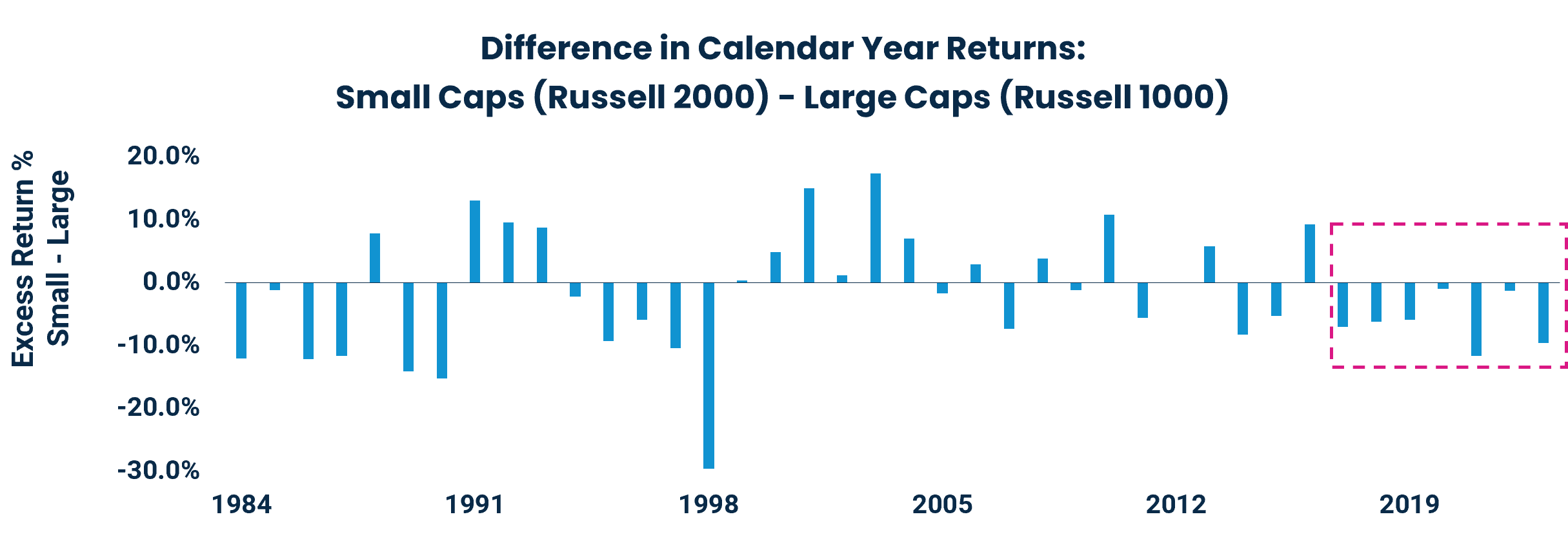
Source: Morningstar Direct; Russell 2000 TR USD & Russell 1000 TR USD monthly, total returns (1/1/1984 – 12/31/2023).
More broadly speaking, although markets are currently at or near all-time highs, the Russell 2000 Index (proxy for small caps) still has some serious catching up to do. In fact, the Russell 2000 has yet to recover from its June 2022 trough – still down over 16 percent in total-return terms from its November 2021 high (and even worse in price terms).
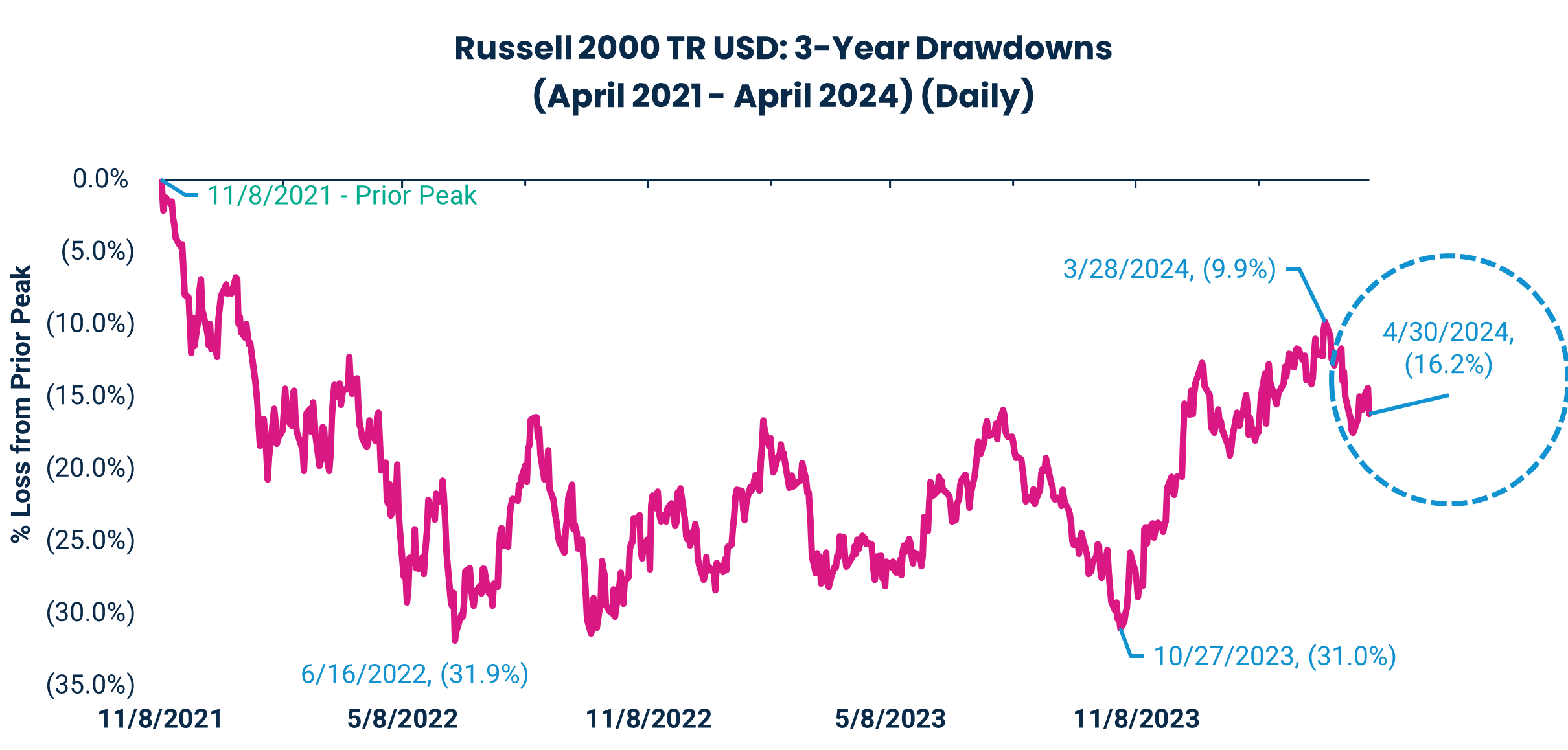
Source: Morningstar Direct; Russell 2000 TR USD daily, total returns.
In fact, this is the third-longest drawdown since the 1984 inception of the Russell 2000 Index. As of 4/30/2024, the Index is going on 904 days and counting without a new high from it's 11/8/2021 peak. The other two instances with droughts of this length were the tech bubble and the global financial crisis.
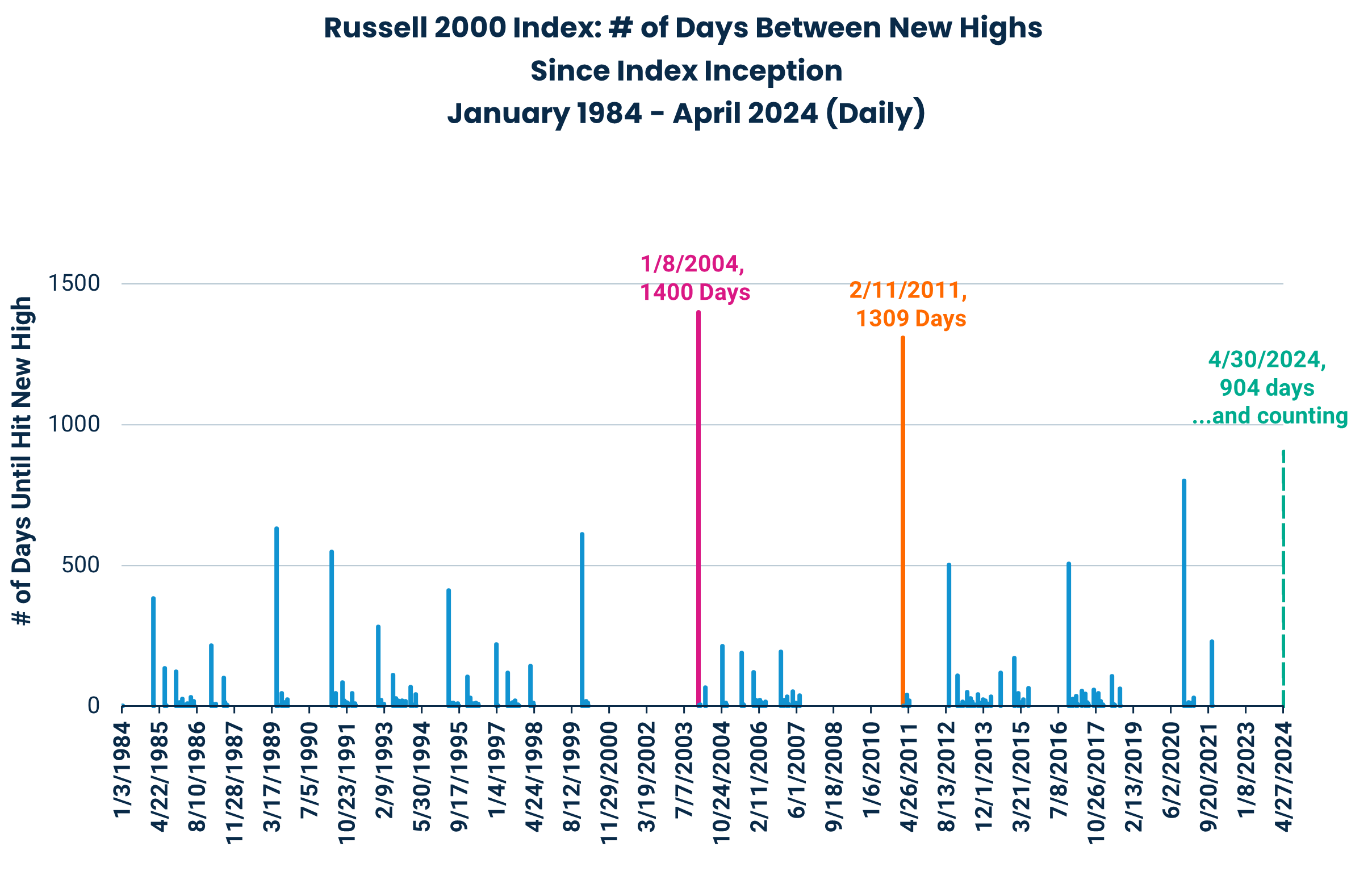
Source: Morningstar Direct; Russell 2000 TR USD daily, total returns from Index Inception (1/1/1984) through 4/30/2024.
After accounting for this drawdown, the ratio of small caps to large caps is at all-time lows, with small caps now sitting at their lowest weighting in the Russell 3000 Index in more than two decades.
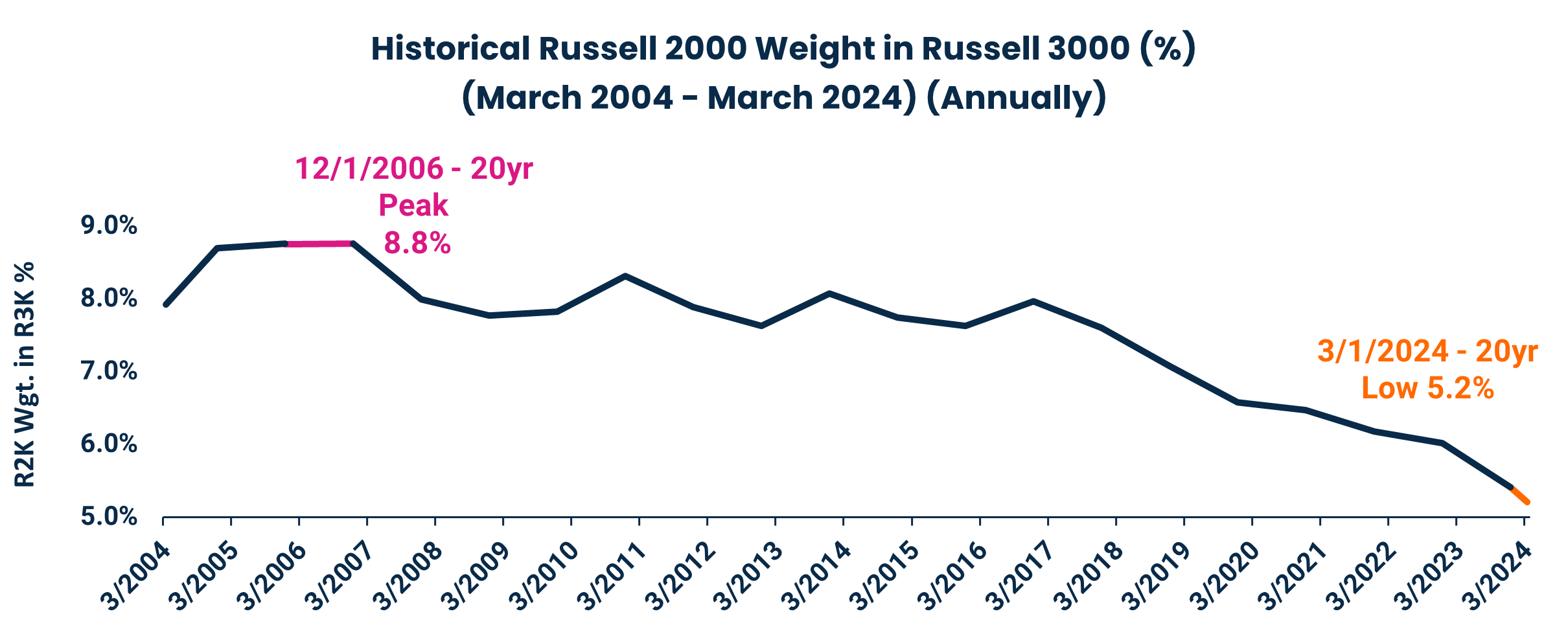
Source: FactSet Research Systems; Russell 2000 Index (R2K) & Russell 3000 Index (R3K) yearly, ending constituent weights (3/31/2004 – 3/31/2024). Weight % calculation = Sum of Russell 3000 weights of Russell 2000 stocks it held per time period.
Notably, small caps’ level of underperformance over the last three years (as of February 29, 2024) represents its worst rolling three-year performance relative to the S&P 500 since the tech bubble.
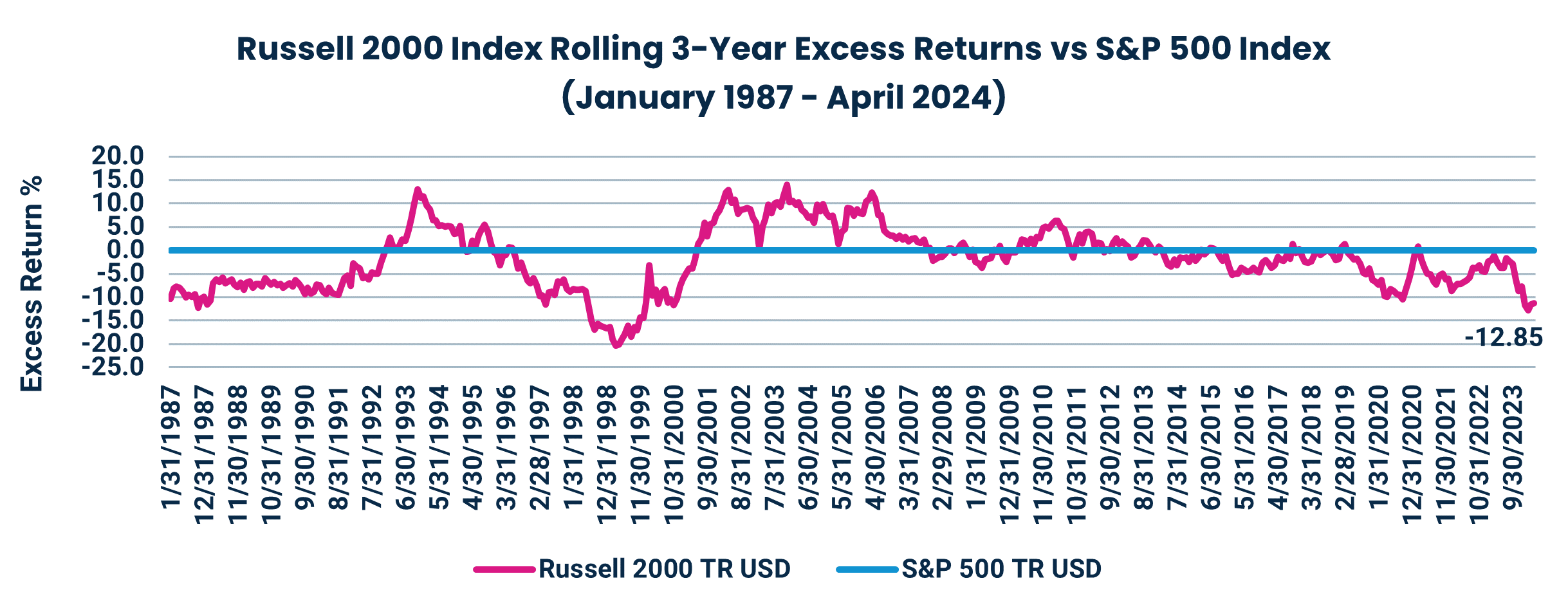
Source: Morningstar Direct.
Q: Why is this happening?
A: It seems complicated, but it’s probably not. Smaller companies tend to be more sensitive to economic cycles and interest rates than their larger counterparts. Over the past few years, the U.S. has been regaining its footing after the global pandemic shocked our economy. Despite many asset classes recovering those 2020 losses, investors are still facing recession fears today. This uncertainty has driven investor dollars towards larger, more stable companies in lieu of smaller, less-established ones.
Additionally, smaller companies rely more heavily on borrowing capital to grow, meaning they typically have a larger debt burden. More debt may mean more interest rate risk, given that small caps tend to take out more floating-rate loans than large caps. Of course, this became a strong headwind as we entered an aggressive rate-hiking cycle from 2022-2023. As rates rose, smaller companies had higher interest rate payments cutting into their bottom lines.
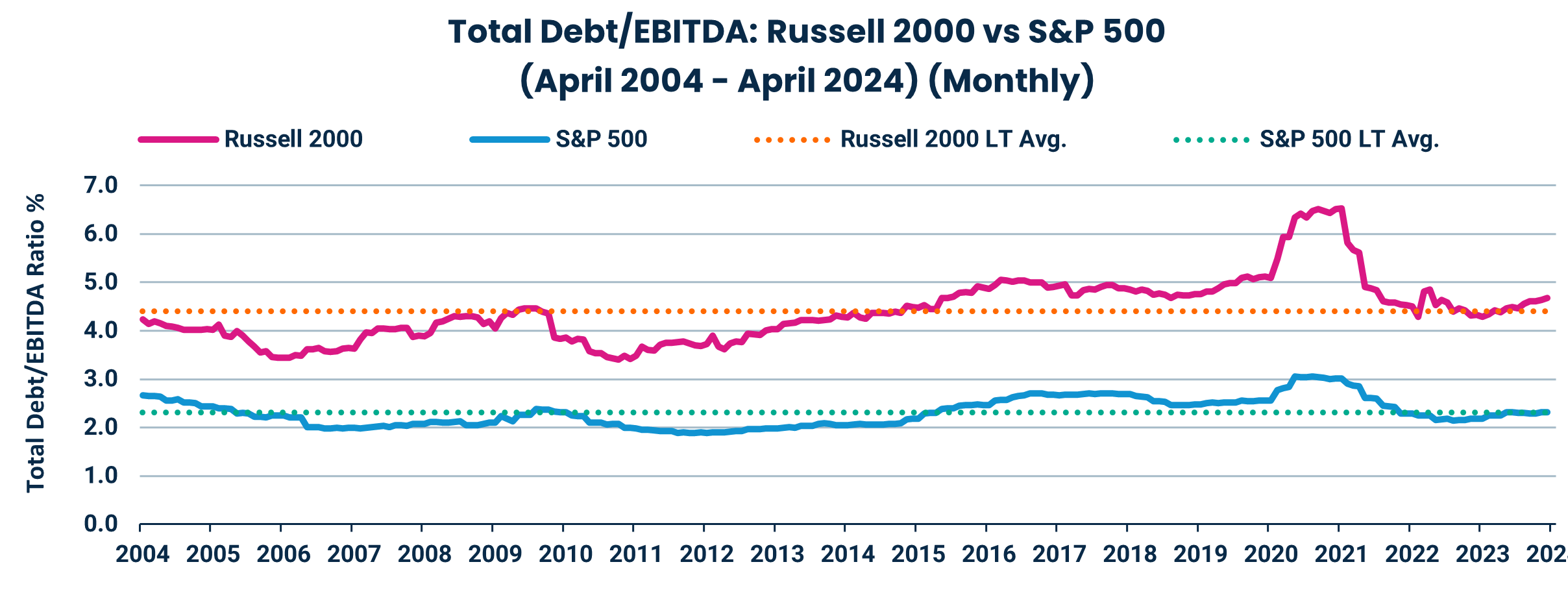
Source: FactSet Research Systems; Total Debt/EBITDA ratio monthly, (4/30/2004 – 4/30/2024). LT Avg. stands for long-term average.
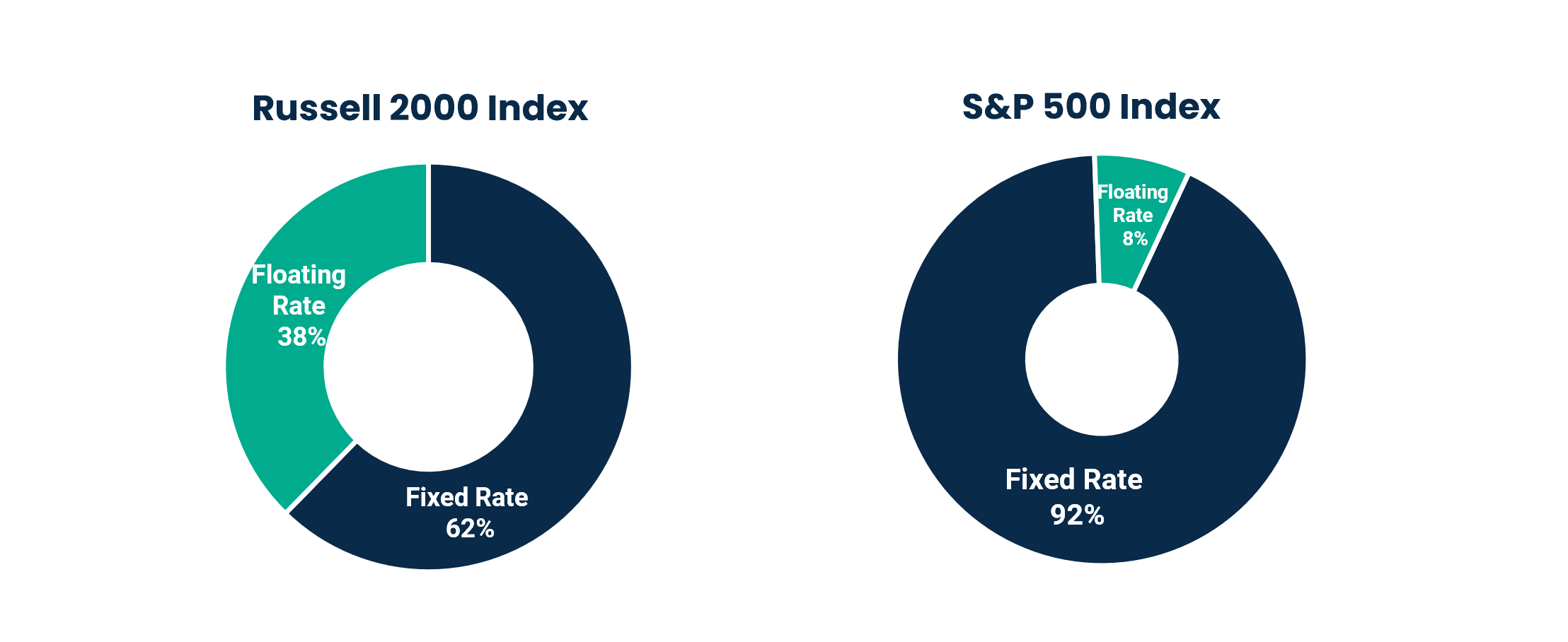
Source: Bloomberg as of 5/16/2024. Fixed rate debt uses a level interest rate over its entire term, with regular interest payments known as coupons. Floating-rate debt refer uses floating interest rate, which change periodically based on market conditions or a relevant benchmark rate, as opposed to a fixed (or unchanging) interest rate.
Q: So, is the small cap risk premium dead – or are there periods where it’s earned?
A: There have been, and will be, periods where the size premium is earned. After long stretches of underperformance, it’s only natural to question the validity of certain strategies. However, the duration of recent relative underperformance isn’t actually all that surprising. Small caps have a long history of prolonged performance cycles compared to larger caps. The average cycle lasts at least a decade, so it’s not unique that the current large-cap period has lasted this long. This performance pattern suggests that, through the lens of building diversified and long-term-oriented portfolios, small caps deserve their place alongside other market caps as we go through various economic and market cycles.
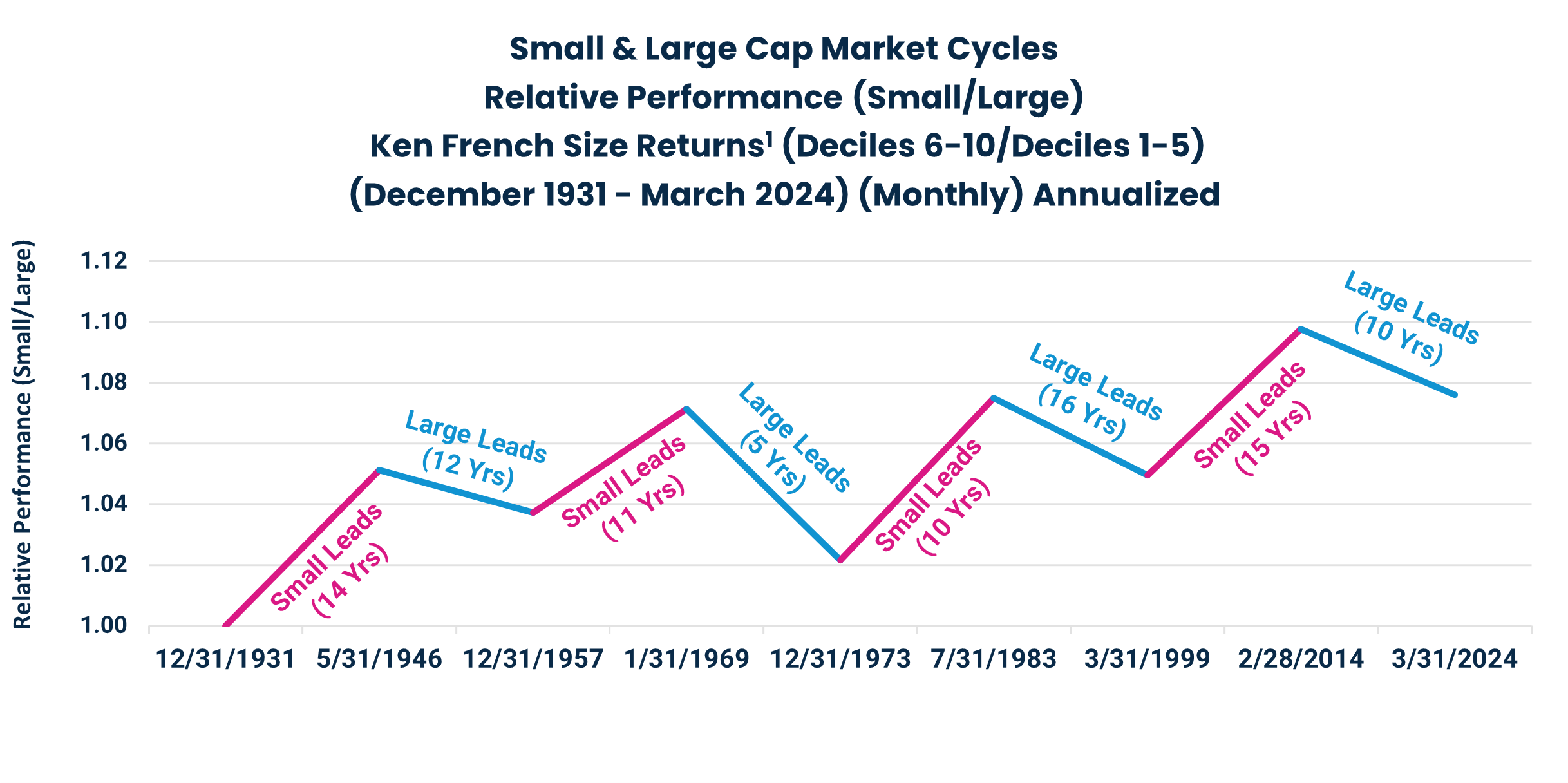
Source: Ken French Data Library using value-weighted, returns averaged monthly for companies in lowest market cap deciles 6-10 divided by highest market cap deciles 1-5. Returns are annualized for each period (12/31/1931-3/31/2024).
Q: This current cycle of underperformance has made small caps look attractive from a price standpoint – but are they cheap for a reason?
A: In many cases, we think it’s a buying opportunity and not a value trap. It’s clear that, on a price-to-earnings (P/E ratio) basis, small cap stocks are trading at much cheaper valuations than large caps. The important question to answer here, however, is whether the Russell 2000 multiple compression is in line with fundamental deterioration. In other words, is the numerator (prices) falling to levels warranted by a falling denominator (earnings)?
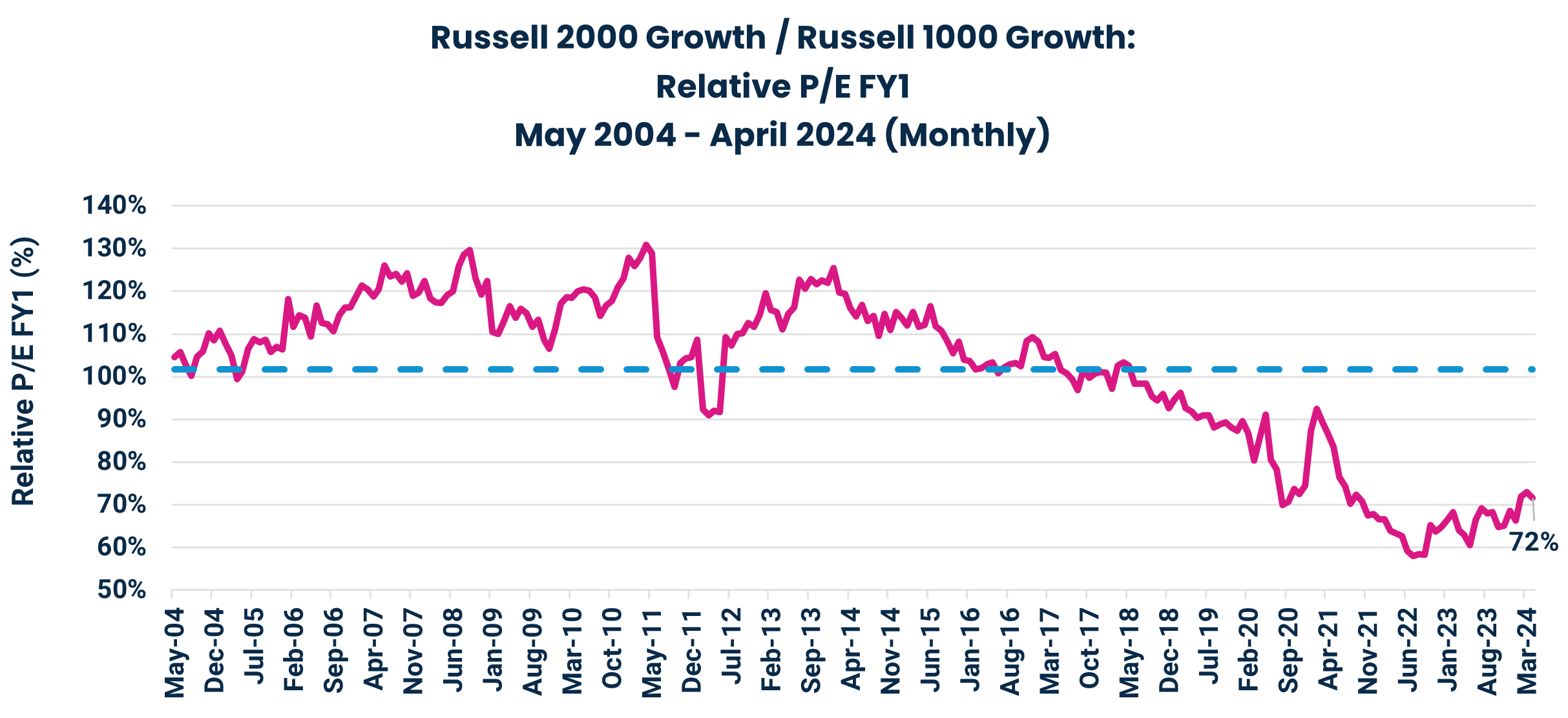
Source: FactSet Research Systems.
To answer this question, we looked at this extended period of underperformance. In the chart below, we see that the S&P 500’s outperformance has been more multiple driven (change in P/E ratio) compared to the Russell 2000 Index. Small caps have exhibited higher realized earnings growth compared to large caps over this time period (which surprised me, a lot). This implies that sentiment has largely driven prices down because the many of the fundamentals still look strong – making this a potential buying opportunity.
Additionally, not only have small caps historically realized higher relative earnings growth, but the second chart shows they are also forecasted to outgrow large caps today. Again, this reiterates that fundamentals are strong and price depression could be more sentiment-driven.
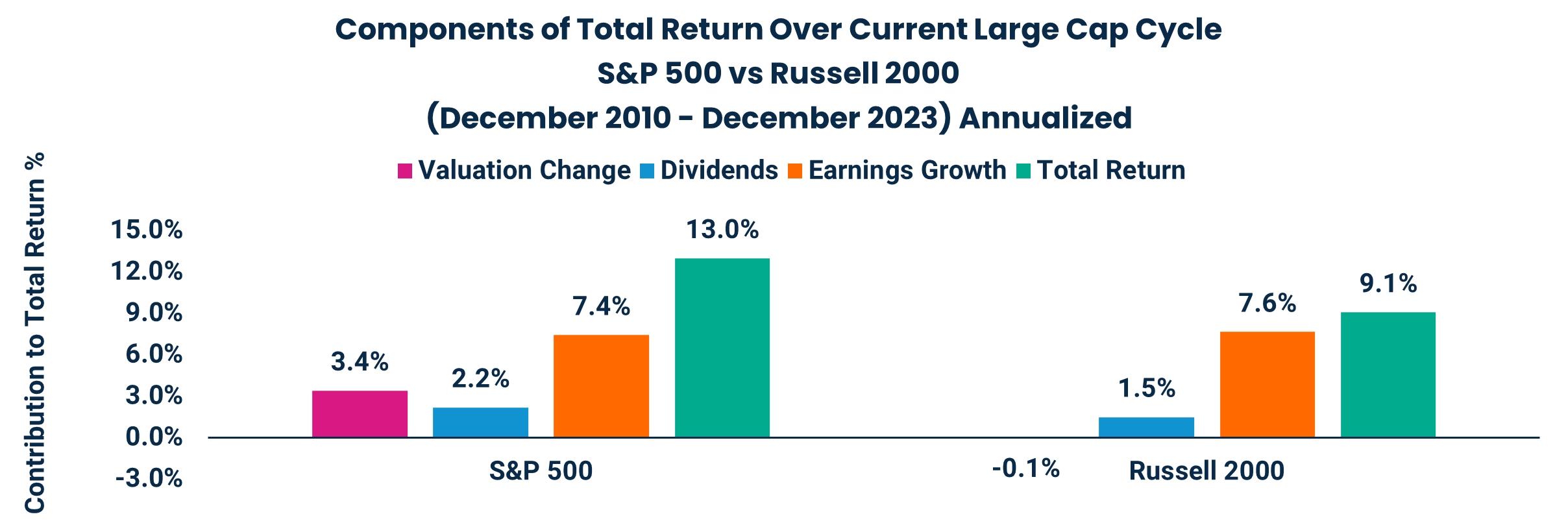
Source: FactSet Research Systems. Valuation Change: % Chg. In P/E (ex. Negatives), Dividends: Dividend Yield, Earnings Growth: % Change in EPS. Calculated 12/31/2010 – 12/31/2023.
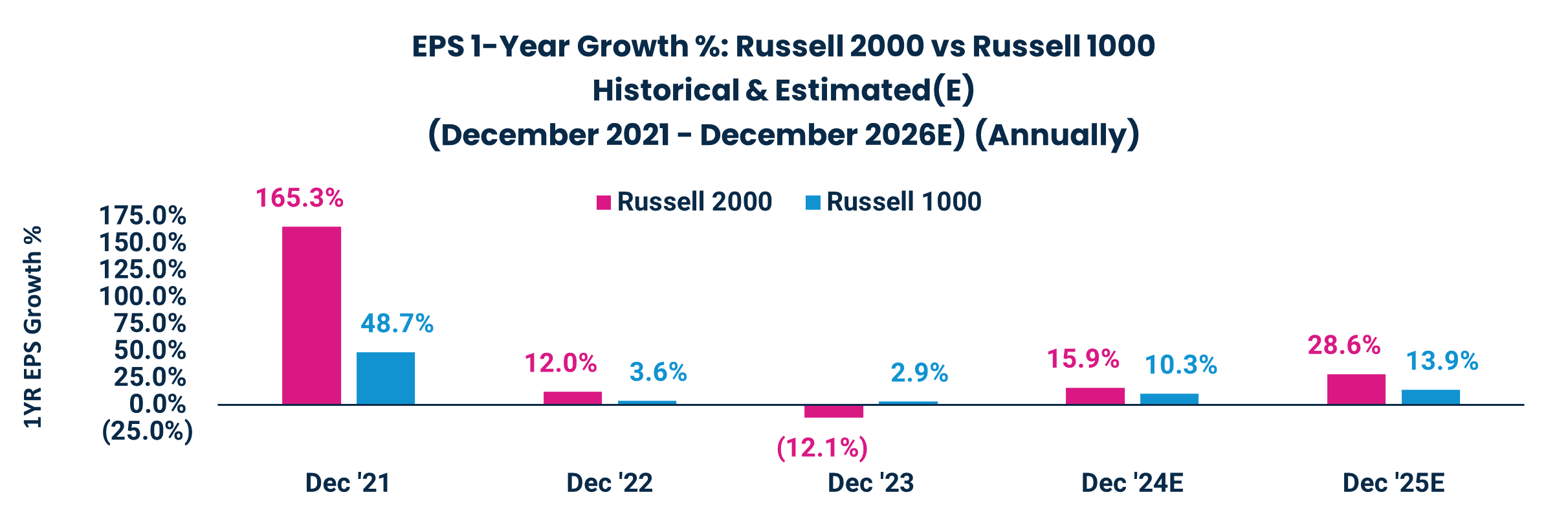
Source: FactSet Research Systems. 1YR EPS Growth historical (2021, 2022, 2023) and estimated (E) (2024, 2025) as of 3/31/2024.
Q: I heard that a record number of small cap stocks are unprofitable. Is this true?
A: Almost. What is true is the number of companies that are unprofitable looks like it has been structurally increasing over the past decade, seemingly before the high interest rate environment really took hold. Over 40 percent of the names and almost 25 percent of the market cap in the Russell 2000 are unprofitable.
If you or your clients are concerned about the percentage of unprofitable small cap companies, you could consider a strategy that seeks to exclude these unprofitable names as a way of improving the quality of exposure to the asset class. Interestingly, we’ve found through our own research that investing in only profitable companies doesn’t mean you sacrifice returns; in fact, simply excluding the unprofitable segment of this asset class can greatly improve returns.
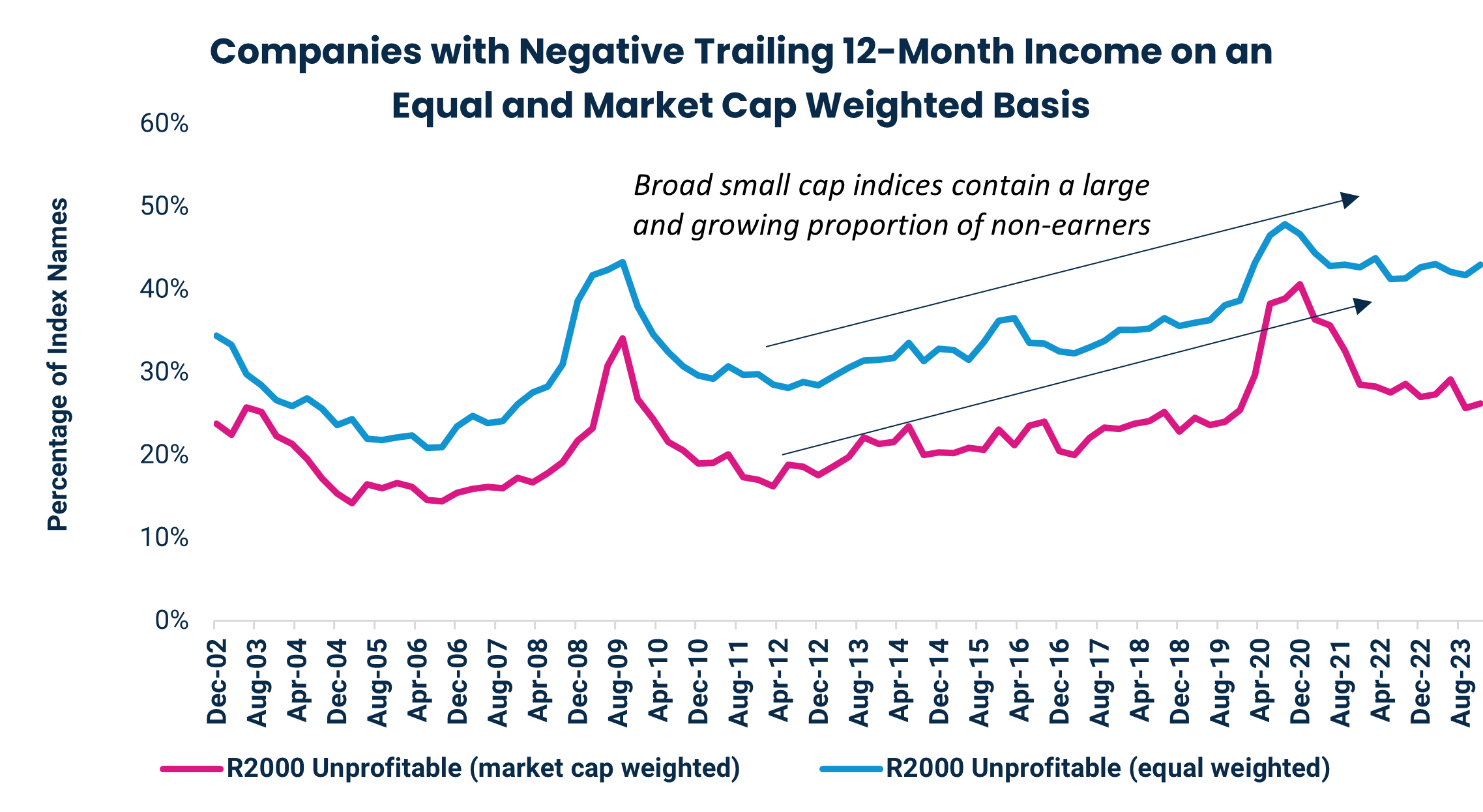
Source: Harbor MAST, FactSet Research Systems as of December 31, 2023. The R2000 unprofitable (market cap weighted) line in blue represents the percentage of total market cap in the Russell 2000 Index that is unprofitable. The unprofitable (equal weighted) line in pink represents the percentage of companies in the Russell 2000 Index that are unprofitable.
In the exhibit below, we show how an index of profitable small cap stocks hypothetically performs versus the broader Russell 2000 Index. We essentially exclude businesses that are more consistently unprofitable by having a three-year look back in the measure. One could make the argument here that “small cap earners”* and small caps (as defined by the Russell 2000 Index) are two very different asset classes.
That said, our findings shouldn’t imply that unprofitable companies equate to poor performance across the board, but rather that going with active managers who can be selective can be really impactful on portfolio returns (we’ll expand on this later on).
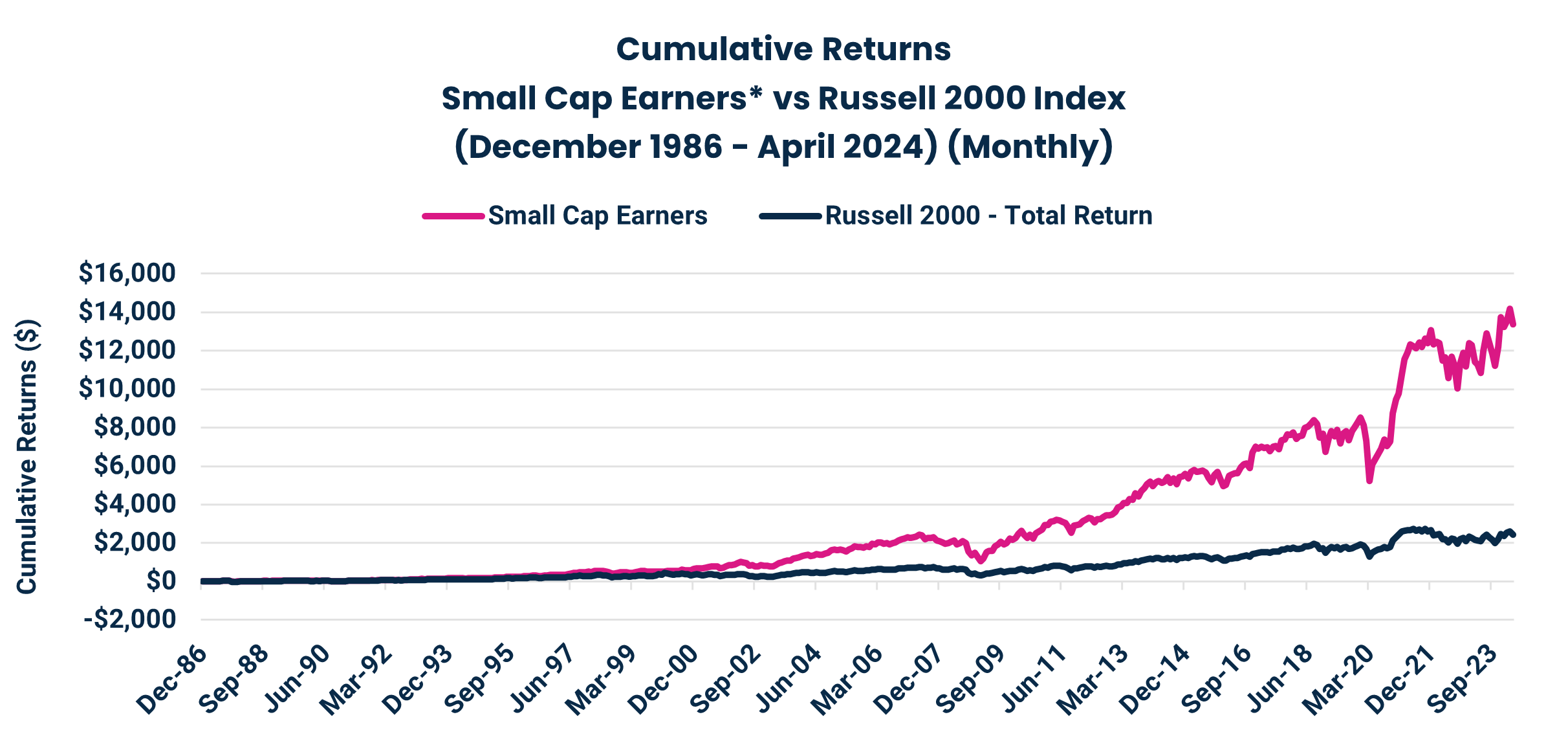
Source: Harbor MAST, FactSet Research Systems. *For these purposes, “Small Cap Earners” are defined as follows: 1) included in the Russell 2000 Index, 2) eliminate companies that earn no or minimal profits, 3) holdings weighted by profits instead of market cap, and 4) maximum 3% issuer weight. In defining profitability, additional information on companies excluded include: 1) have three-year aggregate operating profit of less than one percent of three-year aggregate sales and 2) have a median trailing-twelve-month operating margin (operating profit divided by sales) less than 1% over the prior 12 quarters.
Q: What could change the outlook going forward?
A: Allayed recession fears and a peaked rate-hiking cycle could be near-term factors that might change the tides. Just as higher debt burdens and floating-rate exposures were headwinds, as the Fed hiking cycle stops and cuts enter the equation, both factors could suddenly become tailwinds. We saw an example of that late in 2023 after the Fed stopped hiking and put cuts on the table – the Russell 2000 outperformed the Russell 1000 by 2.3% in the fourth quarter of 2023.
In fact, following the last four rate-hike cycles, small caps went on to produce an average 18.4 percent return in the 12-month period following the final rate hike. In only one instance, small caps delivered a de minimis, negative absolute return. On the other hand, small caps produced double-digit positive returns following the final rate hikes in three of the four rate hike cycles. We’d say that’s a strong track record.
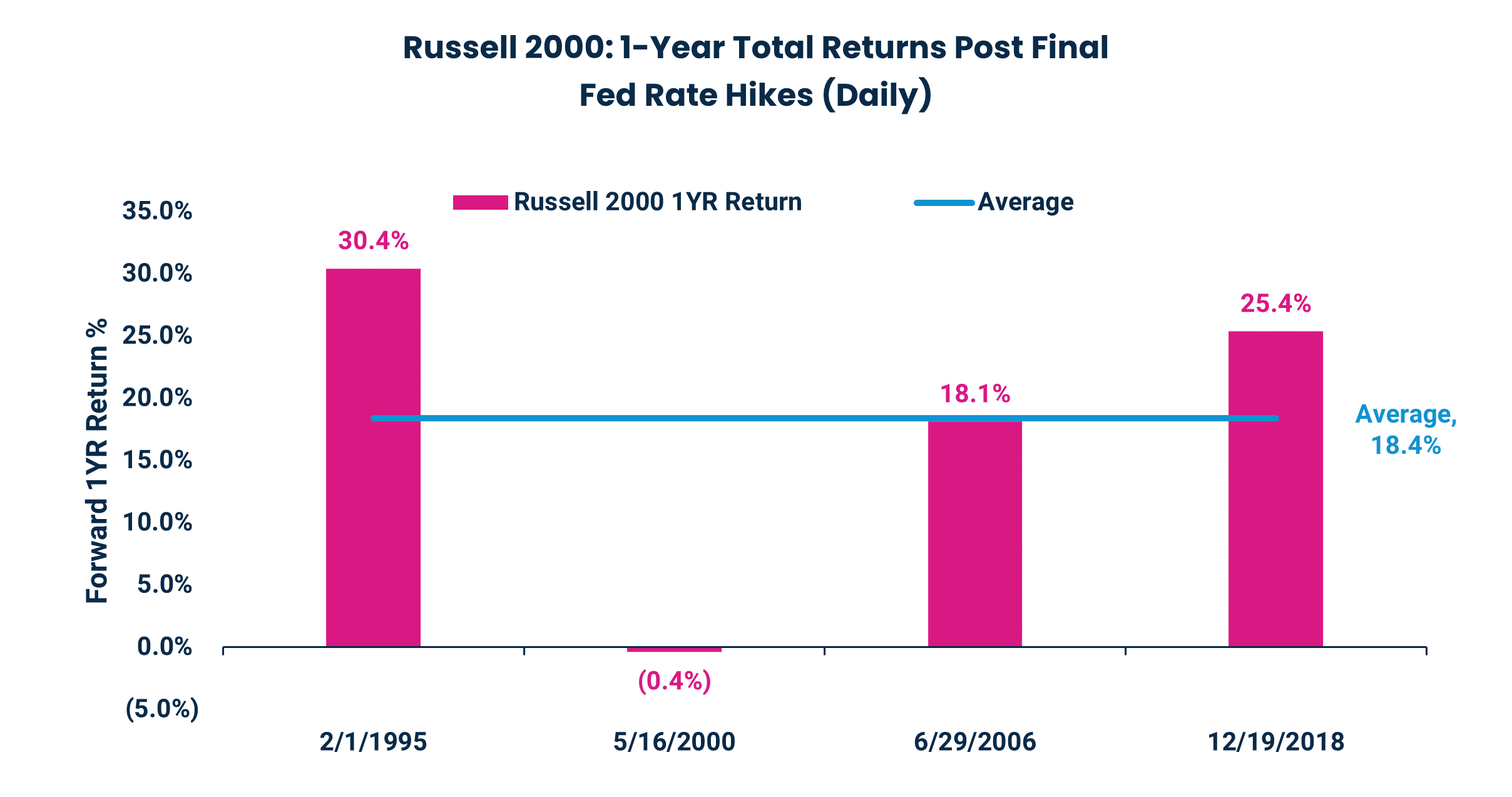
Source: Morningstar Direct; Russell 2000 TR USD daily, total returns (2/1/1995 – 5/12/2024).
Q: What about inflation? It’s been sticky - how should I think about small cap stocks in an inflationary environment?
A: Small cap stocks have historically proven to be very good hedges against inflation in the past. In fact, small caps have comfortably beaten inflation every single decade going back almost 100 years – averaging 11.5 percent per year – which is more than 8 percent above the annual inflation average.
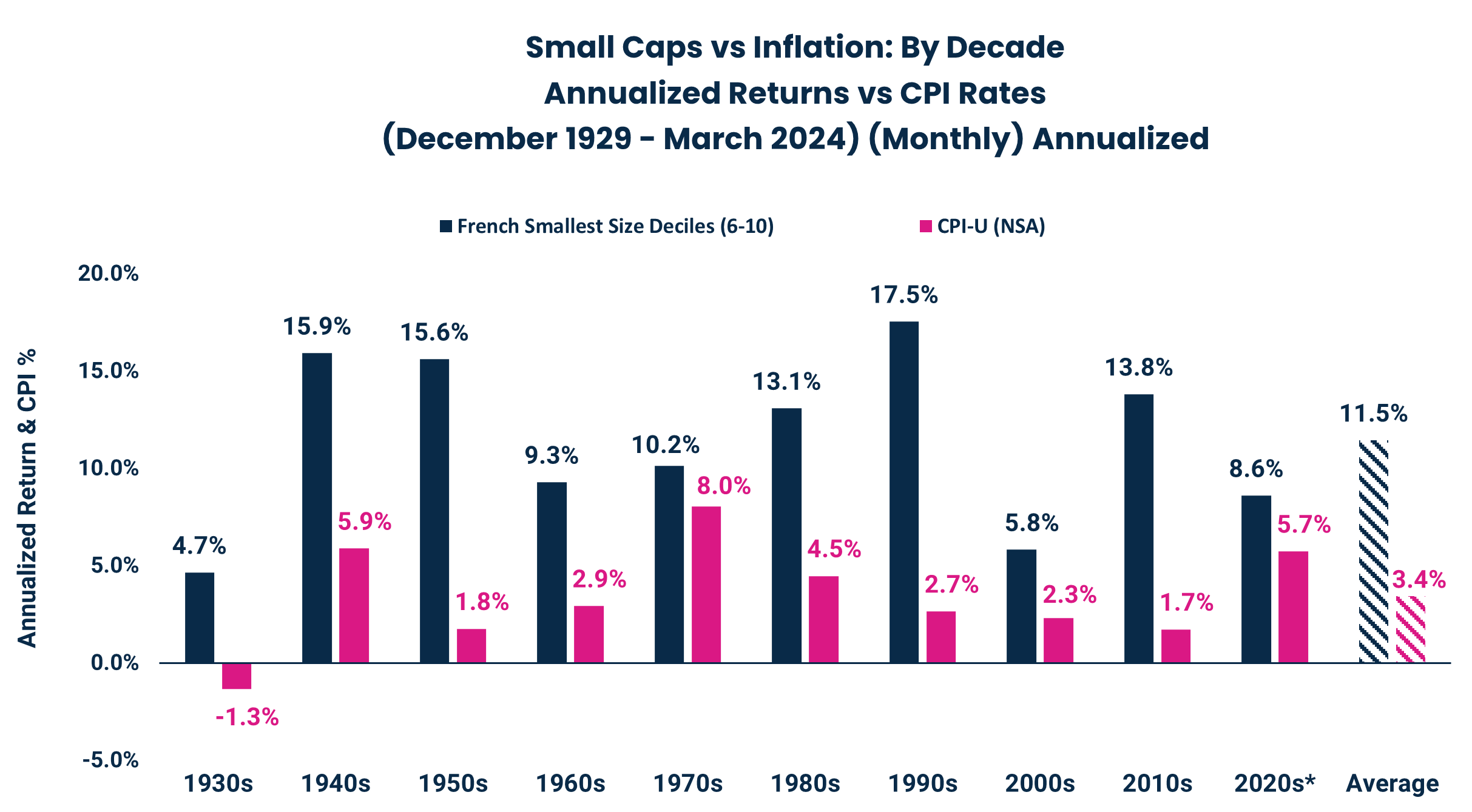
Source: Returns - Ken French Data Library using Size Portfolio monthly, value-weighted returns averaged for stocks in lowest market cap deciles (1-5). Inflation – Consumer Price Index All items in U.S. City (CPI-U) not seasonally adjusted. Returns & CPI Rate Calculations - for each decade start on year-end of first year and end on year-end 12M later (example: 1930s = 12/31/1930 – 12/31/1940) and are annualized. *2020s: 12/31/2020 – 3/31/2024.
Q: What happens if there IS a recession? Should this change the outlook?
A: The answer here – not necessarily. In fact, the data may surprise you. Advisors often remark that they wouldn’t want to touch small caps as the asset class would be too risky in a recession – an intuitive concern that makes sense on the surface. However, it misses the broader point that often this concern is priced in well ahead of any recession actually occurring. If you look back to recessions starting in the early 90s, small caps outperformed large caps twice, underperformed once and performed more or less in line on the other occasion.
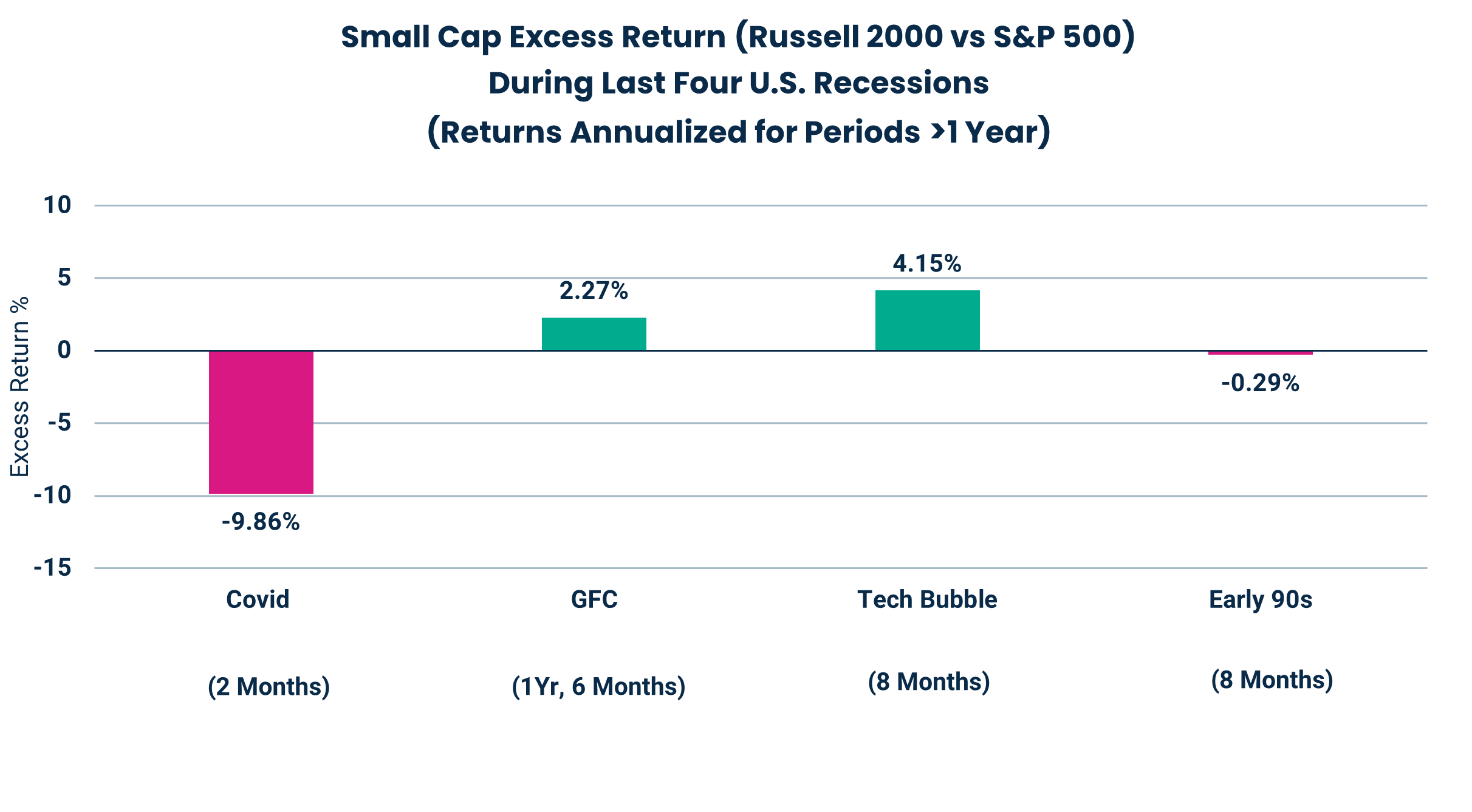
Source: Morningstar Direct. GFC stands for the Great Financial Crisis. Recessions are defined as a decline in gross domestic product for two quarters in a row and cover the periods of August 1990 – May 2024 in the chart above.
Relative to prior recessions, smaller cap companies today already appear greatly discounted compared to larger cap companies. We believe this may act as a potential hedge in the next downturn. Despite valuations being a notoriously poor indicator of short-term performance, a current discount of roughly 50 percent on a weighted median P/E ratio (which helps to eliminate and/or skewing towards outliers) is hard to ignore, especially when you compare this to the other recessions mentioned previously.
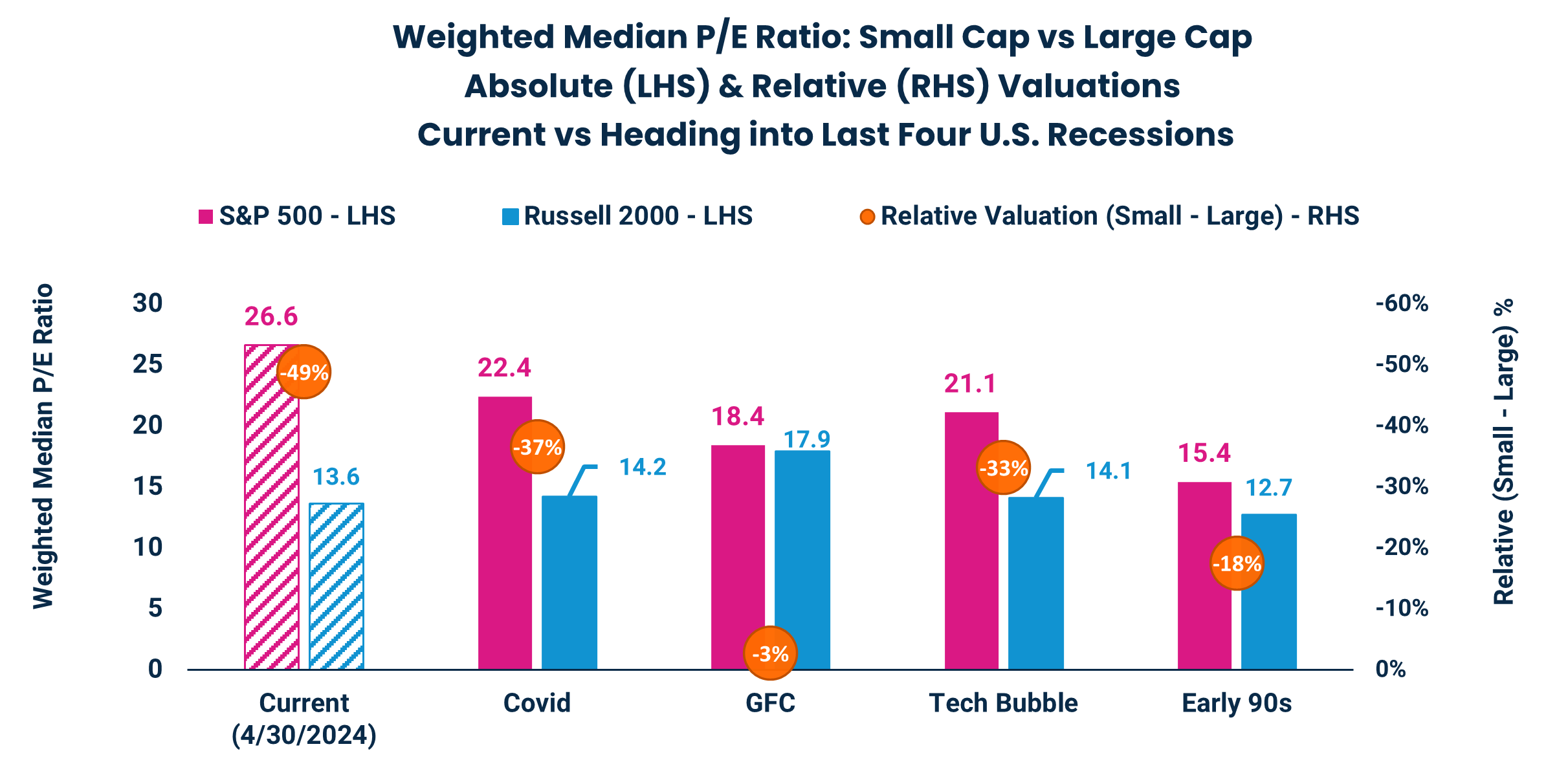
Source: FactSet Research Systems.
Q: Is now the time to consider investing in small caps?
A: All things considered, I don’t see any reason to abandon small caps. In fact, for longer-term-oriented clients, now may be an opportune time to begin to lean back into the asset class.
From a valuation perspective, when you plot the Russell 2000’s historical P/E ratios against forward returns, the relationship shows that the lower the ratio, the more likely you are to see high single- to double-digit future returns. As of April 30, 2024, we stand at around a 17 P/E ratio, which historically would translate to a 10 percent future 5-year, annualized return.
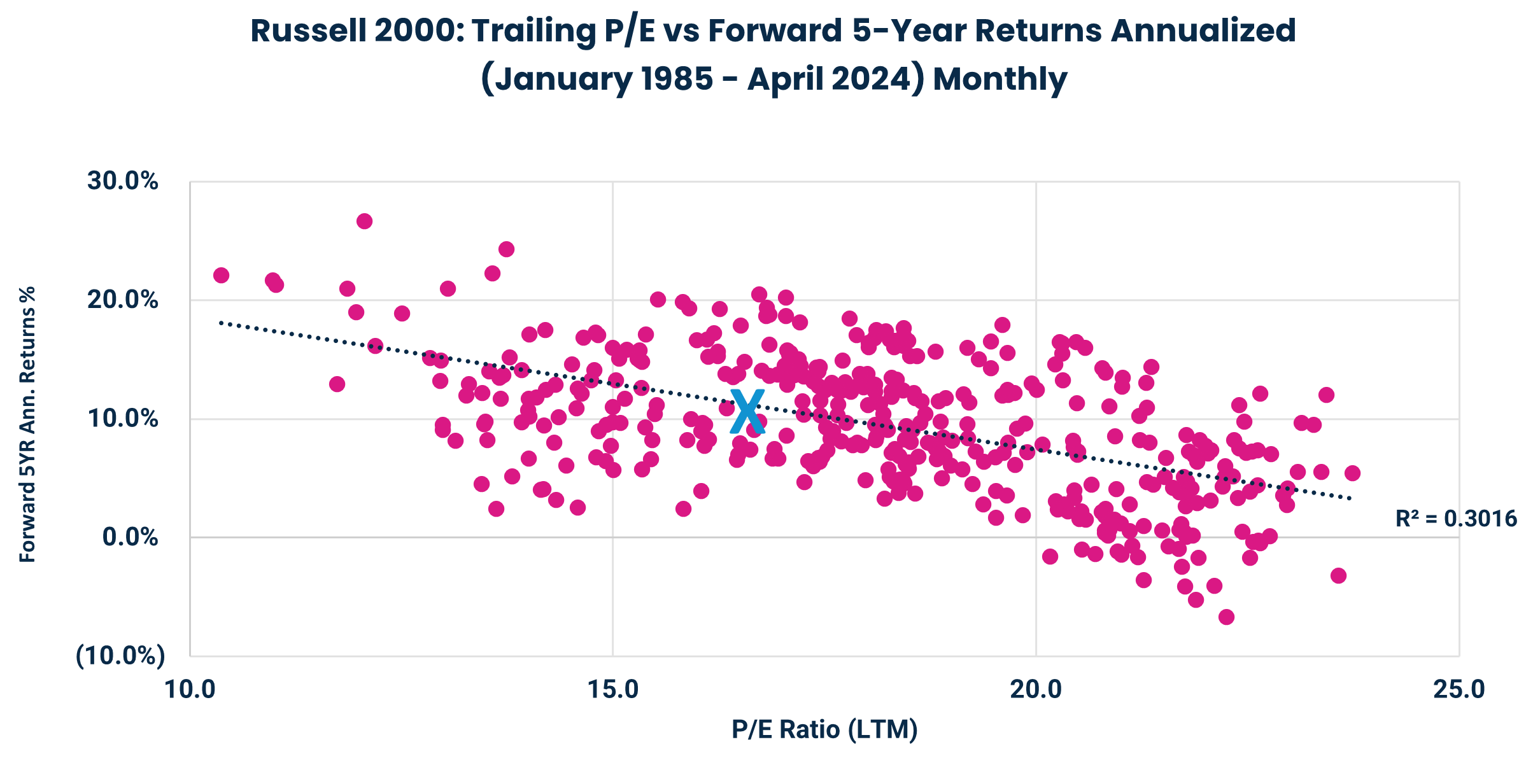
Source: P/E – FactSet Research Systems; Median Monthly Price to Earnings Ratio over Trailing 12 Months (1/31/1985 – 4/30/2024). Source: Returns – Morningstar; Russell 2000 TR USD monthly, total returns (1/31/1985 – 4/30/2024). X = P/E as of 4/30/2024. LTM stands for last 12-months. Forward 5YR stands for the next five-year period from the date measured. R-squared (R2) is defined as a number that tells you how well the independent variable(s) in a statistical model explain the variation in the dependent variable. It goes from 0 to 1, where 1 indicates a perfect fit of the model to the data.
From a performance perspective, if you look at how small caps have performed after periods of a prolonged downturn, forward-looking returns are generally quite strong – both in absolute and relative-to-large caps terms. The average forward one-year absolute and relative returns were +59 percent and +15 percent, respectively. Past performance is obviously no guarantee, but using history as a rough guide, forward-looking small cap returns could be very compelling.
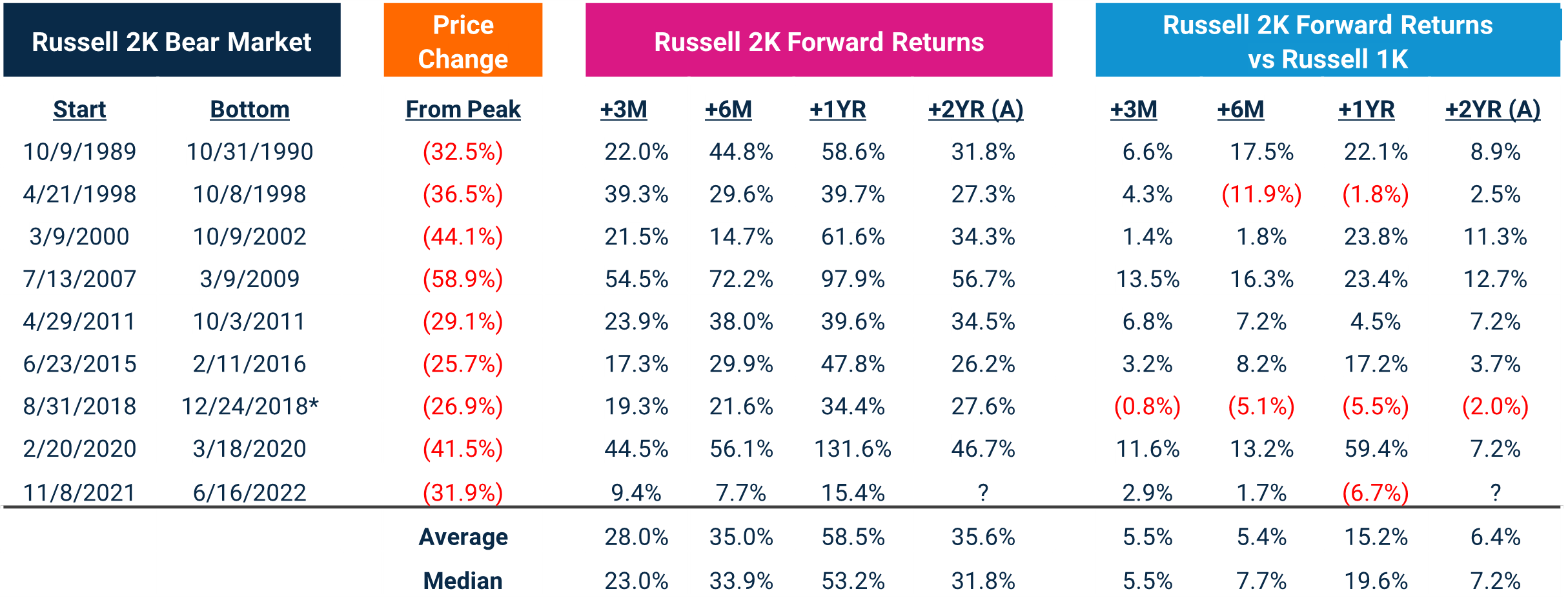
Source: Returns – Morningstar Direct; Russell 2000 TR USD & Russell 1000 TR USD daily, total returns (1/1/1984 – 4/30/2024).
*12/24/2018 is the largest drawdown until 2/20/2020 but the index never fully recovers from 8/31/2018 peak before the 2/20/2020 new bear market starts. The numbers in parentheses represent negative numbers.
Q: If I’m investing in small caps – do I go active or passive?
A: Among clients and advisors, there is a common theme in active management: generally, the further you go down the market cap spectrum, the more active you should be. Is this a good heuristic or a bad one? In actuality, we find that it’s surprisingly accurate. Small companies generally have less sell-side analyst coverage. As a result, they could be considered a more inefficient asset class, where skilled active managers have the potential to earn higher returns from the market. If you look back over the long term, more than half of Morningstar Small Cap active managers generally outperform in any given year. If you think you can identify those managers, then you have the potential to be handsomely rewarded, as there is a wide dispersion of returns between good managers and bad managers.
This exhibit also pulls on the thread noted in my unprofitable answer, where we demonstrated that investing in only the profitable subset of small caps can boost returns, but that shouldn’t mean you ignore the growing, not-yet-profitable companies – considering those companies tend to have higher capital appreciation potential. Instead, we think an active approach is especially important in small caps – especially in the growth space – as close to 50 percent of underlying Russell 2000 Growth companies had negative earnings2 over the last twelve months. You can see that small cap growth managers have the widest dispersion among top and bottom performers (as shown in the following chart within the dotted lines), and also the highest average excess return for all managers. This simply highlights how impactful selecting the right unprofitable companies is on your portfolio returns.
In summary, we believe high-quality active management provides the opportunity to unlock alpha in an inefficient asset class like small caps, justifying its fees.
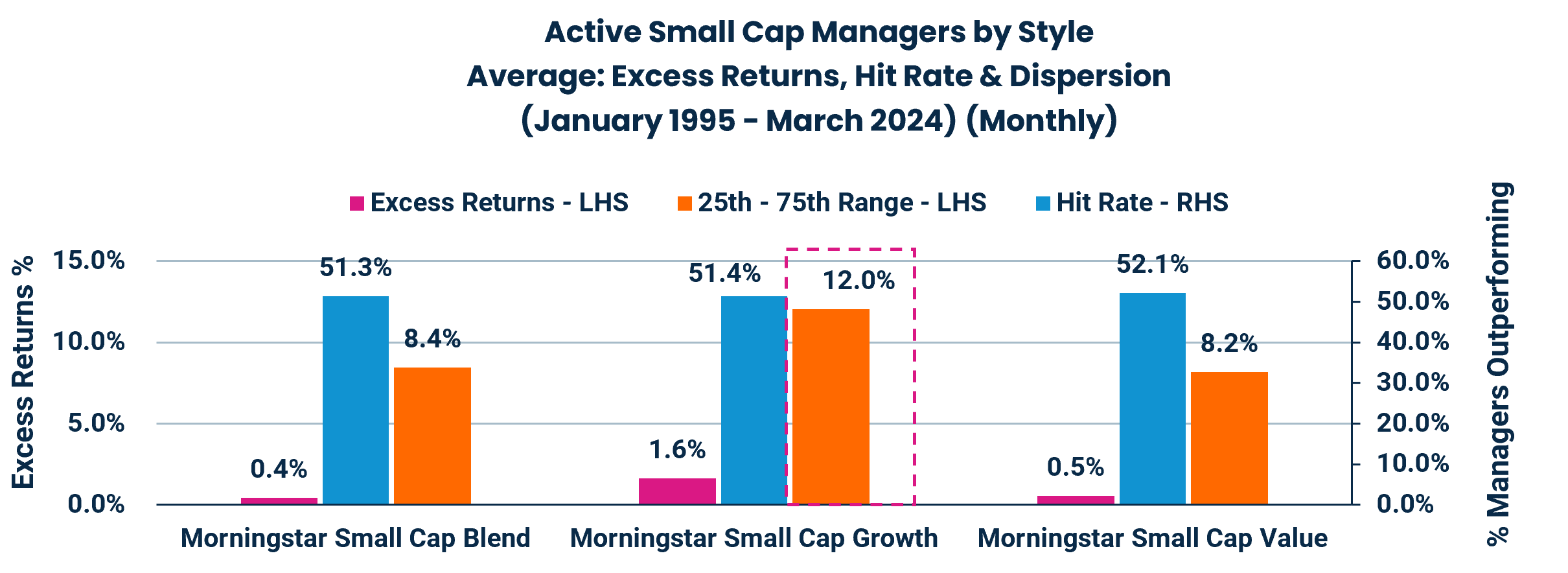
Source: Morningstar; all returns are total and net of fees (1/1/1995-3/31/2024). Hit Rate: % of active managers in each respective Morningstar category outperforming their primary benchmark. Median Excess Return: Median of excess return calculations of each active fund within Morningstar category vs it’s primary benchmark. Dispersion: Percentile Excess Return: (75th percentile –25th percentile of active funds) vs primary benchmarks.
Important Information
The views expressed herein may not be reflective of current opinions, are subject to change without prior notice. This material is for informational and illustrative purposes only. This material does not constitute investment advice and should not be viewed as a current or past recommendation or a solicitation of an offer to buy or sell any securities or to adopt any investment strategy.
Performance data shown represents past performance and is no guarantee of future results.
Investing entails risks and there can be no assurance that any investment will achieve profits or avoid incurring losses.
Investing in stocks of small cap companies involves unique risks, including potential illiquidity and heightened price volatility compared to stocks of larger, more established companies. Small cap stocks may be subject to more abrupt and pronounced fluctuations in market price, and they may be harder to buy and sell without impacting the market price significantly. Investors should consider these factors when assessing the suitability of small cap stocks for their portfolio.
©2024 Morningstar, Inc. All rights reserved. The information contained herein (1) is proprietary to Morningstar and/or its content providers; (2) may not be copied or distributed; and (3) is not warranted to be accurate, complete, or timely. Neither Morningstar nor its content providers are responsible for any damages or losses arising from any use of this information.
Floating-rate loans refer to loans with floating interest rate, which change periodically, as opposed to a fixed (or unchanging) interest rate.
Price-to-earnings (P/E) ratio is the proportion of a company's share price to its earnings per share.
Relative P/E compares the current absolute P/E to a benchmark or a range of past P/Es over a relevant time period.
EBITDA, or earnings before interest, taxes, depreciation, and amortization, is an alternate measure of profitability to net income.
Earnings per share (EPS) is a company's net income subtracted by preferred dividends and then divided by the number of common shares it has outstanding.
Hit rate is the percentage of time when excess return is positive.
The Russell 1000® Index is an unmanaged index generally representative of the top 1000 stocks by market capitalization in the U.S. The Russell 1000® Growth Index is an unmanaged index generally representative of the U.S. market for larger capitalization growth stocks. The Russell 2000® Growth Index is an unmanaged index generally representative of the smallest 2000 stocks with the highest price-to-book ratio and future earnings. The Russell 2000® Index is an unmanaged index generally representative of the smallest 2000 stocks included in the Russell 3000 Index. The Russell 3000® Index is an unmanaged index generally representative of the largest 3000 stocks in the U.S. The Standard & Poor's 500 Index (S&P 500 Index) is an unmanaged index generally representative of the U.S. market for large capitalization equities. These unmanaged indices do not reflect fees and expenses and are not available for direct investment. The Russell Indices listed above and Russell® are trademarks of Frank Russell Company.
Additional Source Information
1 Source: Ken French Data Library; Size portfolios are constructed from 1927 – 2024 using CRSP Index market cap indices. Market Cap is price times shares outstanding (divided by 1,000,000) at month end. The breakpoints for month t use all NYSE stocks that have a CRSP share code of 10 or 11 and have good shares and price data. We exclude closed end funds and REITs. The Size portfolios contain returns for every fifth percentile of Market Cap, from 5% to 100%. Market Cap < 0 (not used); bottom 30%, middle 40%, top 30%; quintiles; deciles. The portfolios are constructed at the end of each June using the June market equity and NYSE breakpoints. The portfolios for July of year t to June of t+1 include all NYSE, AMEX, and NASDAQ stocks for which we have market equity data for June of t.
CRSP Index Methodology: Eligible companies listed on the NYSE are ranked into equally populated deciles at the end of each calendar quarter. The largest capitalizations in each decile serve as the breakpoints that are applied to various exchange groupings of the universe. CRSP’s PERMCO, the permanent company identifier, was created as part of the development that produced the Cap-Based indexes. All market caps of eligible securities of a company are summed and used in creating portfolio assignments, both for setting the breakpoints for NYSE companies, and for assigning all companies to the portfolios. If there is a company with a NYSE security and a NASDAQ security, only the NYSE security market cap is used for setting breakpoints, but the combined market cap is used to add both securities to the same portfolio. Decile results are created for three exchange groups: NYSE and NYSE MKT. NYSE MKT data are added beginning July 1962 NYSE, NYSE MKT and NASDAQ Global and Global Select Markets. The NASDAQ Global and Global Select Markets were formerly the NASDAQ National Market, which was added beginning April 1982. Individual decile portfolios are created for each exchange group, the largest being in decile 1 and the smallest in decile 10. In addition to each decile portfolio, returns are calculated for the following: CRSP 1-2, CRSP 3-5, CRSP 6-8, CRSP 9-10, CRSP 1-5, CRSP 6-10 and CRSP 1-10. The returns of the combined portfolios are not the sum of two or more decile returns. The returns of the combined portfolios are the value-weighted returns of the relevant deciles. Index levels are calculated based on an initial value of one dollar on December 31, 1925. Monthly index returns are calculated based on both daily and monthly security holding period returns. Returns are calculated using prices from end of-period to end-of-period. Total returns always include cash dividends.
2 Source: FactSet Research Systems. Percent of stocks that have negative earnings in Russell 2000 Growth Index calculated as those with negative earnings per share over trailing 12 months (as of 3/31/2024); in the case where trailing 12 months was not reported, included those whose most recent quarter’s EPS were negative (3/31/2024) if it was reported.
3826885
